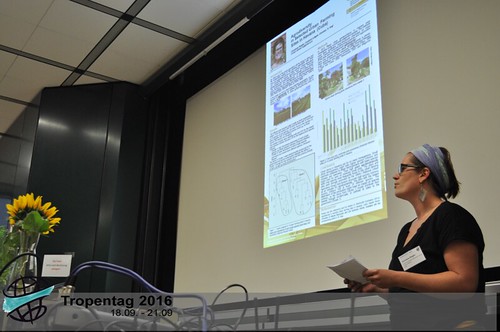Organic Farming Systems: from Kenya to Cuba
The first session of guided posters presentation was held on Monday, 19th September. I personally got particularly interested in the organic farming systems topic. There are six intriguing poster presentations related to current studies on organic farming. The following are the overviews of the presentations:

Christiane Ringler described agrobiodiversity in 15 urban gardening plots in Havanna, Cuba. She found 130 different plant species mostly as leafy vegetables, tubers, fruits and spices from 65 different families, and concluded that small urban farms might have higher species richness and evenness compared to larger gardens.
Bernhard Freyer, head of the Division of Organic Farming at BOKU and among the main organizers of Tropentag 2016, offered a stimulating lecture on growth and productivity of clover in the highlands of the Ethiopian Awi Zone. Different levels of organic treatment applied to clover, farmyard manure, fresh sesbania manure, and a combination of the two manures. As he explained, a high amount of organic manure as fertilizer has a strong impact on clover yield.
Magdalena Manawan, from the Philippines, presented her findings on wild edible and organic minor crops. She found 15 wild edibles and 20 organic minor crops that form part of the household consumption of the Cordillera highlands. Furthermore, she mentioned that indigenous people are good seed keeper.

Naomi Ketter, from Kenya, investigated the growth response of Ethiopian kale and spider plant into organic and plastic mulch. Apparently, by applying different types of mulch, effected vegetative grows in consequence of the effects of soil temperature. A possible conclusion is that, under limited water conditions, hay mulching may be beneficial for spider plant and Ethiopian kale's production
Ulf Schneidewind focused on indicators for carbon cycling in 4 different cacao production systems in Bolivia. According to his research, young cacao agroforesty systems are capable of exhibiting benefits for carbon sequestration and storage in comparison to monoculture.

Christian R. Vogl, instead, explored production conditions of selected urban horticultural plots in Havanna, Cuba. 47 food crop species from 27 families were identified in all plots. Leafy vegetables were the most cultivated species, while lettuce, garden cucumbers and Chinese cabbage demonstrated to be the species with highest yields per hectare.





Comments
Post new comment